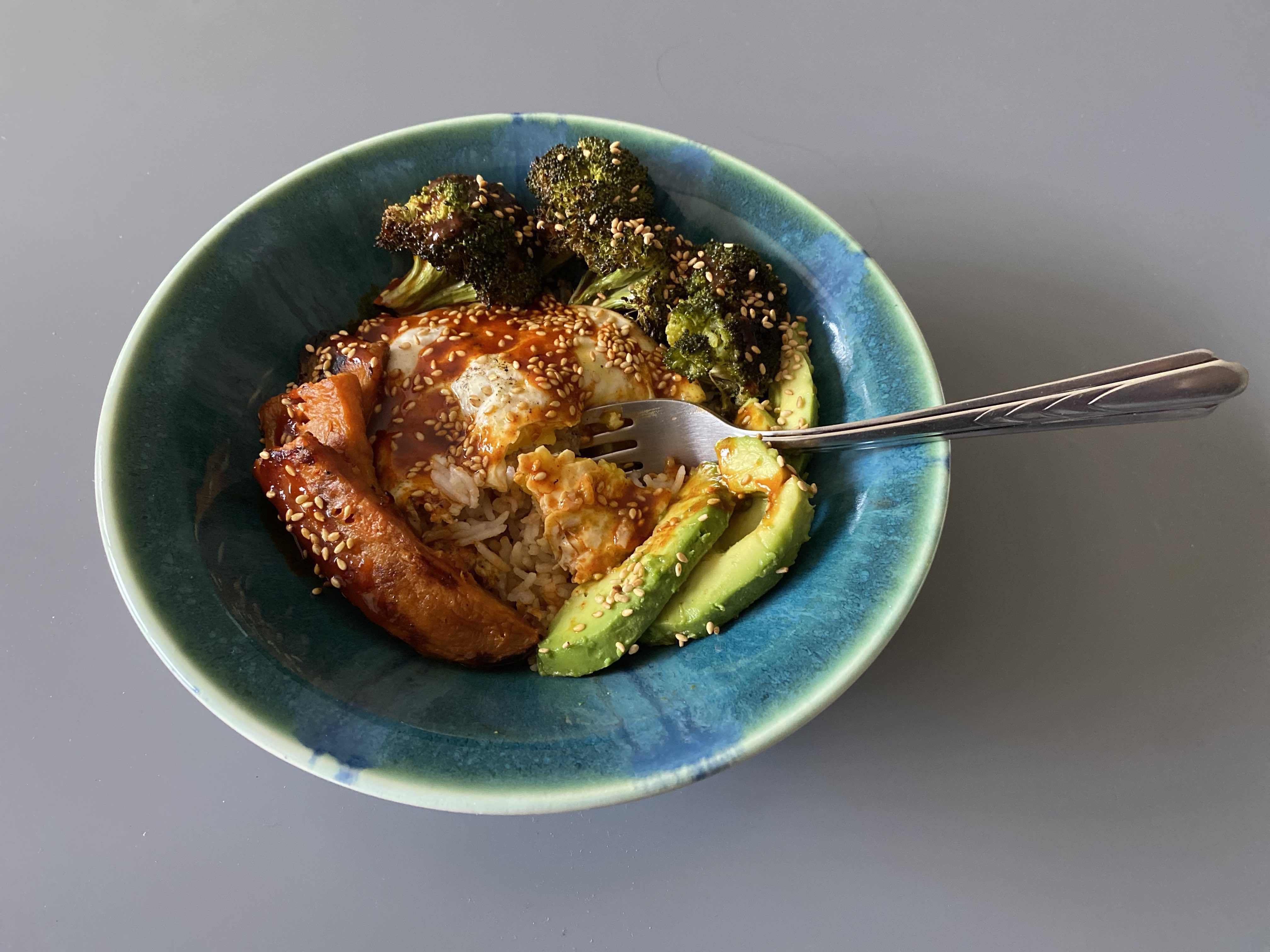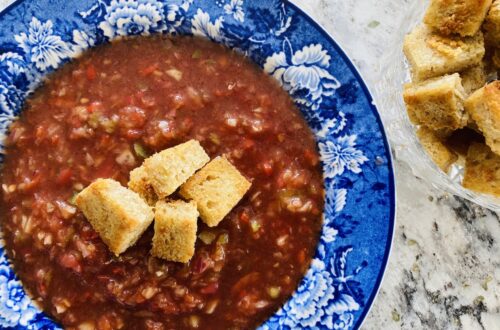Spicy Sweet Potato and Broccoli Rice Bowl
I love recipes that are adaptable – that can be made with whatever vegetables you have at home, that can be baked or pan-fried depending on your mood, and that always end up tasting delicious – even when you set off the smoke alarm while cooking. I now bake the vegetables, which is (1) easier, and (2) hasn’t yet set off a smoke alarm.
This recipe is from East, author Meera Sodha’s amazing collection of flavorful vegetarian recipes. (Check out her column in The Guardian for more great recipes.) I’m obsessed with this cookbook – as many people who I’ve evangelized about it to know. Every recipe is tasty and flavorful, but also simple, with never more than a dozen ingredients. It’s vegetarian food that never makes you feel like you’re missing meat.
And now, to this post’s ingredient. Since I have already written about key ingredients like sweet potatoes, rice, and avocados, this post is on soy sauce – and therefore, soy. Let’s start with what soy sauce actually is. It’s a 2000-year-old sauce made of soy beans, wheat, salt, and a fermenting agent (like mold or yeast). Soy sauce is traditionally made by cooking soybeans until they are soft, and then adding mold (“bacterial and fungal cultures”) and, in some cases, roasted wheat. The mixture is then combined with a salt brine, after which is “brews” for a set period of time. Once the sauce has fermented, it is pressed to separate the brown liquid – the soy sauce. Soy sauce sold in supermarkets usually ferments for about six months, although high-end soy sauce can ferment for longer.
There are many types of soy sauce: tamari (Japanese-style soy sauce that is generally a by-product of making miso, it traditionally contains no wheat), shoyu (a broad term for Japanese-style soy sauce), shiro (Japanese-style soy sauce with more wheat), light soy sauce (the most common Chinese-style soy sauce), dark soy sauce (also Chinese-style but used to season dishes and often contains sugar or molasses) reduced sodium soy sauce, and many, many more. Chinese, Japanese, and Korean soy sauces – not to mention Malaysian, Singaporean, and Indonesian – are all a bit different, with Chinese-style soy sauce using less wheat than Japanese-style, while Korean soy sauce is generally produced from fermenting soy bean paste and doesn’t include wheat.
I could go on and on about types of soy sauce, but let’s talk about soy – the depressing part of the post. The US, Brazil, and Argentina produce about 80 percent of all soy, so the soy story is really a story of these three countries. Soy cultivation is responsible for massive deforestation, especially in South America. Deforestation contributes to climate change and leads to a decrease in animal and plant diversity. Meanwhile soy production can cause soil erosion, contaminate water supplies, and put a strain on water sources. In Brazil, soy cultivation threatens the land where about 650,000 Brazilian Indians live. As is so often the case, indigenous communities are most threatened by large agricultural production.
The good news for soy sauce consumers is that soy sauce (and other soy products like tofu) are not the cause of this mass deforestation. Only 6 percent of soy production is consumed directly by humans. Livestock production – meaning the feed for pork, beef, chickens, and even farmed fish – is the real reason for the overwhelming majority of soy production. Soy is cheap, which makes for great food for livestock. But that has a real cost. To reduce your soy intake, don’t skimp on soy sauce or tofu. Instead, eat less meat.
Spicy Sweet Potato and Broccoli Rice Bowl
Course: Dinner, Recipe4
servings45
minutesThere are a few parts to this recipe. Remember to make the rice while the vegetables are cooking (and please remember to rinse the rice!). And it’s okay if you fry the eggs after everything is already done — the vegetables won’t get cold that quickly. Additionally, watch out for how spicy the gochujang sauce is. It will vary depending on the brand that you buy, but it can bring some real heat.
Adapted from Sweet Potato and Broccolini Bibimbap in Meera Sodha’s amazing newest cookbook, East.
Ingredients
- Bowl
Two medium sweet potatoes (about 1.5 pounds), peeled and cut into 1/2-inch slices
2 small heads of broccoli or broccolini (about 1.5 pounds), cut into small pieces
4 tablespoons canola or vegetable oil (1 tablespoon each for the sweet potatoes and broccoli and the rest for frying the eggs)
4 eggs
2 cups of cooked rice
2 avocados, sliced
2½ tablespoons soy sauce
2½ tablespoons toasted sesame oil
1 clove of garlic, crushed
Sesame seeds to serve
- Spicy Sauce
4 tablespoons gochujang paste
3 tablespoons toasted sesame oil
1½ tablespoons soy sauce
1½ tablespoons honey
1½ tablespoons rice vinegar
Directions
- Preheat the oven to 400˚F. Mix the sweet potatoes and broccoli with a tablespoon each of canola oil and lay flat on separate baking sheets lined with parchment paper.
- Put the sweet potatoes in the oven and bake for about 40 minutes. After 20 minutes, flip the sweet potatoes and return to the oven. Put the broccoli in the oven and cook both for another 20 minutes until both vegetables are tender and have nice charred bits on them.
- While the vegetables are baking, mix together the soy sauce, toasted sesame oil, and the garlic in a small bowl. Set aside to drizzle over the sweet potatoes and broccoli when they come out of the oven.
- Next, make the spicy sauce. Mix together the gochujang paste, toasted sesame oil, soy sauce, honey, and rice vinegar. Set aside to be drizzled over the dish right before serving.
- Right as the vegetables are finished cooking, fry the eggs. Heat a cast-iron skillet or other heavy-bottomed pan over medium-high heat. Add canola oil as needed to fry each egg. Once the oil is hot, crack the eggs into the pan and cook to your desired consistency. (I like the whites to be set but the yolk to still be runny. To hit this, cook only about 10-15 seconds once you’ve flipped the egg.)
- To serve, add rice to a bowl, then sweet potatoes, broccoli, avocado and the egg. Drizzle with the spicy sauce and serve.






